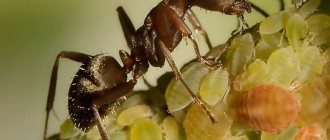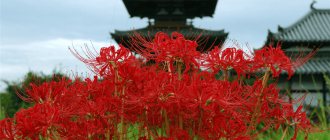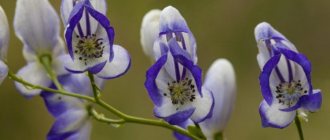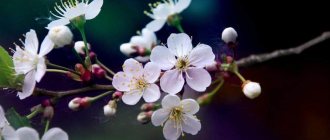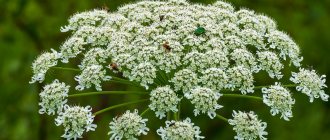The orchid flower is one of the beautiful and unique representatives of the green world. You probably won’t find a gardener who doesn’t like this amazing plant. You can find everything about orchids in our article.
It was first mentioned at the beginning of the 7th century BC. e., but some experts believe that people learned about representatives of the orchid family much earlier.
From ancient times to this day, the plant symbolizes chastity, harmony, and perfection.
Mention of the orchid flower in ancient manuscripts
Among culture lovers, there is an opinion that varieties of orchids are the result of the work of modern breeders, but this reasoning is erroneous.
Records of exotic flowers have been found in Chinese manuscripts. In addition, the ancient Chinese alphabet had the character “lan”, meaning the word “orchid”, and its varieties:
- celestial orchid - “Tin Lang”;
- orchid scent - “Lan Fong”;
- resembling an orchid - “Yeuk Lan”.
In addition, Chinese artists, and later Japanese ones, painted birds next to orchids.
One of the manuscripts, dating back to 700, reported on an artist who grew an unusual flower at home.
In his philosophical writings, the Chinese sage Confucius compared the phrases uttered by close friends to the delicate fragrance of noble plants.
Collectors had to master cultivation techniques
Foragers had to learn how to properly care for the delicate flowers to protect their investment. For the longest time, people didn't know how to grow orchids and simply watched their investments wither and die. B. S. Williams found a solution. In 1851 he published his first guide to growing orchids. This book offered tips and tricks. The publication became a hit in this area.
Homeland of the orchid
Today the flower has conquered the whole world. These noble tropical inhabitants grow on almost all continents, except in deserts and where polar bears live.
In Russia alone there are more than five hundred species of orchids. This diversity is explained by climatic conditions and natural methods of growth, which is why many plants are divided into:
- epiphytes;
- lithophytes;
- herbaceous.
For each of them, their homeland is a place with the most comfortable natural conditions for growth.
Epiphytes
The tropics are the habitat of most epiphytic species, since the hot and humid climate of tropical latitudes, where prolonged rains are replaced by prolonged drought, is ideal for orchids.
It is no coincidence that flowers are comfortable:
- in tropical rainforests of South America;
- India;
- Indonesia;
- southwest Asia;
- in the north of the Australian continent.
Epiphytes grow on trees, but are not parasitic because they do not feed on the sap of the plants on which they live. Tree trunks serve as a support for flowers to hold on to with strong roots.
The roots absorb moisture from raindrops, and light promotes photosynthesis. Epiphytes have thick stems because they contain a lot of stored moisture, due to which orchids easily tolerate drought.
Climatic conditions affect the life cycle of plants. With the onset of the dry season, the development of flowers slows down, only to then grow and bloom rapidly.
Litofitov
Flowers grow on rocky and rocky mountain slopes. Plant growth and development also require a humid climate. Since flowers live above sea level, they easily tolerate temperature fluctuations.
Peru, Venezuela, Brazil - countries with a tropical climate are considered the birthplace of lithophytes.
grassy
These representatives of the orchid family grow and develop exclusively in their natural habitat. Plants in indoor pots will die.
Flowers prefer temperate climates:
- South America and North;
- European countries;
- Central Asia.
Lyubka bifolia, Lady's slipper - orchids growing in Russian regions are so rare that they are listed in the Red Book.
Diversity of species in the natural environment
The Phalaenopsis genus includes approximately 70 plant species , most of which are epiphytic, living on other plants.
But this does not mean that they can be classified as parasites. They use them exclusively as a stand or support, without sucking out the juices. They obtain nutrients from leaves, pieces of bark, etc., and absorb moisture directly from the air (in tropical forests there is high humidity due to frequent rains and thick fogs). In their natural environment, phalaenopis feel comfortable on the bark of all kinds of trees and clumps of dry grass. Some representatives of wild orchids inhabit the lower tier of the forest and even grow on stones. They are also called lithophytes.
The very name of the flower translated from Greek means “night butterfly” , because the inflorescences of phalaenopsis are very similar to multi-colored, variegated and bright butterflies. The rich color palette of their colors is amazing: in nature there are snow-white and blue, soft pink and red, etc.
Saprophytes
Saprophytic phalaenopsis includes many species. Their main feature is that they do not have green leaves, like all the flowers we are used to. They have one shoot, which is covered with scales and at the end of which flowers form. Plants of this group have a powerful, developed root system, similar to coral. Separate roots do not emanate from the main rhizome; it nourishes the plant by absorbing moisture and microelements from humus necessary for life over its entire surface.
Epiphytes
Most existing orchid species belong to the group of epiphytic plants. They grow in tropical forests on trees, on rocks, and for normal life they need high humidity and air temperature. Their main difference is the ability to exist without soil, since their aerial roots and long creeping stems absorb sunlight and moisture from the environment (from dew, fog, rain).
Epiphytic plants have thin stems that are not able to stand upright on their own. Therefore, they mainly use trees as support. All absorbed nutrients accumulate in the fleshy leaves of flowers and their root tubers.
Only epiphytes are grown at home, and due to their characteristics and habitual habitat, they require special care. Care at home includes periodically moistening the plant and maintaining air humidity.
Terrestrial species
Terrestrial species grow on soil. These types of orchids are the most familiar to us, since they have ordinary green leaves and roots that grow in the ground. Their habitat is Europe and North America. In these areas, orchids grow to a maximum of 0.5 m, and in tropical zones - up to 1 m and higher, creating a bush with several peduncles.
This is interesting: How to care for echeveria at home
Terrestrial species are accustomed to the change of seasons, because of this their life activity is divided into several periods - a period of active growth, flowering, reproduction and dormancy. In the summer, they form new storage lateral roots, called root cones. Throughout the winter they wait underground, and in the spring new stems grow from them.
Origin story
There is no consensus among flower growers about the history of the origin of flowers. Some believe that the birthplace of the orchid is China, others call it South America.
For the first time, plants with this name were reported by the Greek thinker Theophrastus (IV-V centuries BC). In his work on the medicinal properties of the inhabitants of the plant world, he talks about flowers with two tubercles and rounded roots, to which he gave the name “orchis” (translated from Greek “egg”).
When talking about the origin of flowers, one should keep in mind not just one country, but a place where the climate is humid, the plants are abundantly green, through which the sun occasionally peeks. There are places in China that are favorable for orchids, and it is possible that the plant’s homeland is Chinese forests.
Non-standard application
It is interesting that the orchid has never been perceived solely as a flower - beautiful, but by default useless. On the contrary, it was actively used in various spheres of life and everyday life, and often in the most unexpected manifestations. Different peoples had their own views not only on the practical benefits of orchids, but also on their magical powers.
- Young men of Papua and New Guinea, undergoing an initiation rite, decorated their bodies with blooming orchids. A number of potions were also made from the plant to help fight rheumatism, skin rashes, high blood pressure, and neuralgia.
- To gain the attention and appreciation of girls, Zulu boys glued Ansellia orchid petals to their shoulders. Bright yellow inflorescences, strewn with red spots, symbolized the power of intentions and acted as a kind of “barker”.
Other parts of the flower were also used, especially when it came to love pleasures. A tincture from the root was used as Viagra, and the pseudobulb was used to make a contraceptive paste. The smoke of burnt roots helped get rid of nightmares and ward off evil spirits.
- The Zaporozhye Cossacks also knew how to handle orchids. Unlike the aborigines, they focused not on the sexual, but on the nutritional “abilities” of the flower. Orchis pseudobulbs were added to food, which made the dishes more tasty and satisfying. Dried inflorescences were very popular and were used as dry rations. One such “bead” could suppress the hunger of an adult for the whole day.
First documentary mentions
Orchids were first mentioned in 500 BC. e.
- Ancient Chinese manuscripts reported two types of flowers: cymbidiums and cegolines.
- The ancient sage Confucius spoke about plants.
- For about 2.5 thousand years, the hieroglyph “lan” has existed, which describes orchids.
- A Chinese manuscript (700 BC) tells the story of an artist named Wang Wei who managed to grow a flower outside its natural environment.
A piece of amber found in the Dominican Republic with a bee frozen inside and a piece of an organ belonging to an orchid stuck to it. The discovered amber, according to scientists, is approximately 18 million years old.
Orchid hunters become rivals
Rival teams fought each other for flowers and territories. According to one story, an orchid hunter named William Arnold crossed paths with another tracker in the jungles of Venezuela. Arnold followed his rival and collected the same flowers that his rival discovered. It all ended with Arnold urinating on the specimens his opponent had already collected. Naturally, the tender plants died.
There were other stories of hunters stealing rare specimens and even holding colleagues at gunpoint to gain information on the whereabouts of the best species.
A simple recipe for strawberry cheesecake with cookies and delicate buttercream
If you have nowhere to put the candy cans, we make a pot in the old style
The smallest Christmas tree in the world is the size of a DNA strand: it was created by a student
Appearance in Europe
European countries could not resist the refined beauty of exotic plants.
In the 18th century, a botanist from England was given an orchid tuber sent from the Bahamas. A year later, an unusual flower blossomed for the scientist, the beauty and fragrance of which amazed the sedate Englishmen.
There were so many people who wanted to have tropical flowers at home that they started talking about the orchid disease that was sweeping the country.
A century passed until the British learned to grow tropical plants in artificial conditions to satisfy the demand of all residents. Attempts to create the necessary conditions for plant growth and development often failed. But the efforts were not in vain - majestic exotic flowers of different orchid colors bloomed in English gardens and greenhouses.
From England, a triumphal procession of plants began throughout Europe. Demand exceeded supply for a long time.
Resourceful traders went to the distant Amazon to buy exotic flowers, where they often died at the hands of rivals or bites of insects and snakes.
Legends and myths about phalaenopsis
The most unpretentious and popular orchid is phalaenopsis . Includes more than 70 species. Its name means “butterfly-like.”
Dutch botanist Carl Blume, while traveling around the islands of the Malay Archipelago, mistook these flowers for butterflies from afar. As he came closer, he was amazed by their beauty. This is how the name “phalaenopsis” arose.
Phalaenopsis
Australia, the Philippines and Asia are considered the homeland of phalaenopsis.
In world mythology, there are several legends about the birth of Phalaenopsis :
- In Ancient Greece, its origin was associated with the goddess of love Aphrodite. A beautiful flower grew in the place where the goddess dropped her shoe.
- According to a New Zealand Maori legend, an orchid was born from fragments of a rainbow.
It is phalaenopsis that is the ancestor of indoor species.
Where was it brought to Russia from?
In the 19th century, pan-European interest in orchids also spread to Russia. The deliveries were carried out by Sandler's company.
These are good times for exotic fans (wealthy people). It became possible to purchase simple types of flowers without leaving the homeland, and rare specimens were ordered from abroad.
This is how priceless private collections were born.
The mass worship of exotic flowers by the nobility is evidenced by the fact that in the period from 1892 to the October Revolution in 1917, more than a dozen books on growing plants of the orchid family were published, most of which were written by domestic authors.
The second wave of interest in orchids came in the post-war years. Exotics were brought to the USSR from Germany, from greenhouses owned by Goering. The Moscow Botanical Garden began to cultivate many varieties of tropical exotics.
Variety of orchid varieties
According to their growth characteristics, plants are divided into 2 large groups.
- Flowers grow horizontally. They reproduce in the same position. The plants look like vines spreading in different directions; new roots with pseudobulbs emerge from the axils of the leaves. Plants are called sympodial: Cattleya, Cambria, Cybidium, Oncidium.
- Monopodial flowers are those that grow vertically from one point. Shoots grow from the axils of the leaf blades and stretch upward.
More than thirty thousand plants of the orchid family are known, and the number is growing every year. Among them there are several important groups.
- Brassia. South America - where these orchids come from. Another name for the flower is “spider”. There are approximately 35 varieties of this species. Spotted and Warty are the most famous.
- Cattleya. Plants are sympodial in growth type. More than 187 varieties belong to this species. Orchids can be any color, but not blue. At home they bloom once a year.
- Cumbria. Flower growth type is sympodial. The variety of colors is amazing.
- Ampelous orchids - cybidium. They require simple care. Japan and Australia are the birthplace of the plant. They bloom magnificently and have an exquisite fragrance.
- Phalaenopsis is one of the most famous orchids on our windowsills. All flowers are similar in shape to butterflies (they are called butterflies), and the variety of colors is great. The plant growth type is monopodial.
Thanks to the work of modern breeders, new varieties and hybrids of orchids have appeared.
How does culture grow?
Under natural conditions, orchids bloom several times a year. There is practically no rest period, despite the fact that it is typical for other members of the family.
As a rule, there are no or very rare climatic and temperature changes in the area where phalaenopsis grows. This promotes constant and active growth.
This is interesting: What to do with gloxinia after flowering: rules for care at home
In botany, there are such concepts as biological and forced rest. So, after the appearance of a new shoot, the orchid goes on a well-deserved biological rest. And if the plant is affected by negative environmental factors, it goes into a stage of forced dormancy, waiting for the right moment to awaken.
Favorable environment for flowering
Native tropical forests are considered the most favorable living environment for phalaenopsis. Long daylight hours, optimal temperature and humidity, good air circulation and reliable protection from the scorching sun contribute perfectly to the excellent growth and reproduction of the flower.
Life cycle
There is practically no rest period in wild phalaenopsis, although it is observed in other orchids. The climate in which the flower grows rarely changes. There are no sudden changes in temperature or cold snaps, and this promotes constant growth.
There is a concept called biological and forced rest. After a new shoot grows, the flower retires. This happens under favorable climatic conditions. If the temperature, moisture or any other conditions are not suitable for it, then the phalaenopsis goes into a phase of forced dormancy and waits for the right moment to awaken.
Varieties of wild orchids differ from each other in appearance or in the characteristics of development and reproduction. But these plants have one thing in common - high life expectancy. In the wild, these exotics can live from 60 to 80 years. And some long-lived specimens can grow for more than a century.
Reproduction
The natural method of propagation of wild orchids is by seed.
The delicate aroma and extraordinary beauty of the plant serve as a bait for numerous insects, which carry out pollination. Over time, when the flowering of phalaenopsis comes to an end, an oblong seed pod appears on the peduncle. After its opening, the seed leaves the mother plant, enters the soil and begins independent life. The first step on this path is the germination of the first shoots and leaves.
Orchid seeds can germinate even after 2 years!
It also happens that an orchid forms babies (small sprouts) directly on peduncles or on aerial roots. This happens after part of the plant is damaged by animals.
The homeland of the indoor orchid is China.
More than four thousand years ago, the Chinese cultivated orchids outside natural conditions. The biography of indoor orchids begins with Phalaenopsis - one of the ancestors of domestic flowers.
In their homeland, China, plants preferred to grow in low-lying, humid forests, up to half a kilometer above sea level. Therefore, Phalaenopsis grown in nature does not look the same as an indoor flower, since hybrids grow on window sills, in the cultivation of which the scientific method of mixing dozens of ancestral species was used, which is why the individual properties of the plant have changed.
The height of an adult home flower is from 20 cm, but not more than half a meter. If you compare how many leaves there should be, the differences are obvious: 2-3 pairs in phalaenopsis; more than a dozen - in dendrobium and vanda.
Thanks to a scientific approach, it was possible to adapt capricious tropical inhabitants to home maintenance.
Key Facts
- The name of the genus comes from the Greek. phalaina – night butterfly, moth, opsis – resemblance.
Orchids can be grown in the back of the room under artificial light. But wherever the flower stands, it needs 12 hours of daylight.
- Among domestic fluorescent lamps, “LD” or “LDC”, which produce white light, are suitable for illuminating phalaenopsis.
- The roots of the flower are capable of photosynthesis, and in places illuminated by sunlight they are colored green by chlorophyll.
- Plants that bloom in winter require more abundant watering than plants that do not bloom. For their normal development, it is necessary that the root system is not overcooled.
- Planting small specimens and children differs only in the size of the substrate particles. In the lower part of the pot, above the drainage, you can use a fraction of up to 1.5 cm, the rest of the bark should be no more than 1 cm.
In large bark, children and small specimens develop poorly.
- Due to low humidity, orchid roots on the surface of the substrate often have a wrinkled, non-viable appearance, but this is not a reason for concern.
- If it is not possible to give the plant illumination in winter, you can switch it to spring-summer flowering and have a rest in winter.
- To plant phalaenopsis babies, you can use pure sphagnum moss. But in this case, watering is more difficult, leaves grow faster, and roots grow worse.
- During flowering, it is advisable to tie the flower stalks to a peg.
